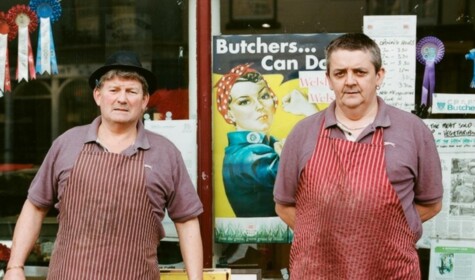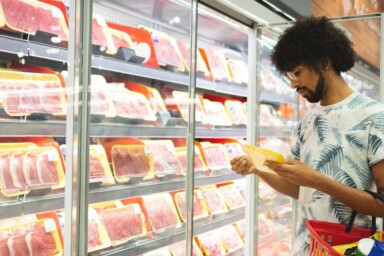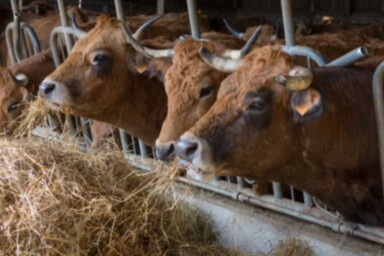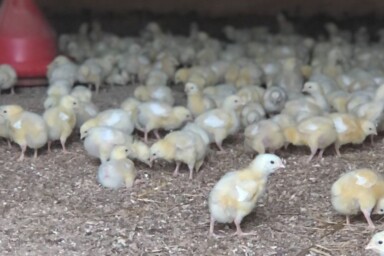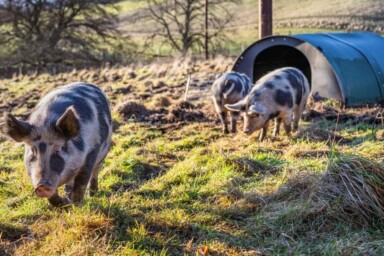Pressure is building to make our food system in the UK more sustainable and transparent than ever. But with concerns over feeding a nation, especially during this Christmas period, it is clear that a change in tactics is urgently needed to improve the balance between productivity and sustainability. In the UK meat industry, for example, one answer to improve this balance, according to recent Sustainable Food Trust findings, is to increase the number of local abattoirs in the supply chain.
I spoke to the following farmers, butchers (many of whom run local, small-scale abattoirs) and consumers, the whole ‘field to fork’ journey, to hear why local abattoirs are important in making our food system more transparent and sustainable.
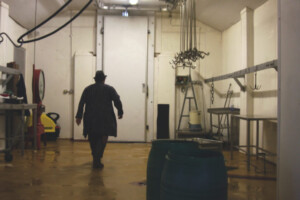
John Mettrick is a 5th generation butcher at Mettrick’s Butchers in Glossop, Derbyshire. Alongside his brother, Steven, John runs a small-scale abattoir next to the butcher’s shop. John talks about how their local abattoir helps the farmers they work with, ‘We provide a service for farmers that adds value to their product. We are able to sell their meat in our shop or send it back to them, which they can then sell at markets or through box schemes.’ This, John tells me, generates more income for the farmers, than if they were to sell their animals to a livestock market.
One of the farmers that John and Steven Mettrick work with is Shelia Oliver, who farms in the local High Peak District. Shelia talks about how using Mettrick’s Butchers helps her exist as a farmer, ‘Our business has gone from strength to strength, and a large part of that is down to having a local abattoir that has the ability to slaughter local livestock for local people. People wouldn’t be able to eat local, sustainable meat without them. Without Mettrick’s, we wouldn’t exist. It’s as simple as that. We greatly depend on them as a local service.’
Callum Edge is a 6th generation butcher at Edge & Sons Butchers in the Wirral, who also runs a small-scale abattoir. ‘Without our services, many of the small-scale farmers we work with would fall out of business due to no fault of their own. We are able to slaughter, cut and prepare their meat, after which, we can send it back to them to sell locally. If they were to sell their livestock to larger abattoirs, they’d never see their meat again.’
Jane Oglesby is a farmer who uses Edge & Sons Butchers. She talks about how important their local abattoir is to her, ‘It’s the direct communication with Callum that is so fantastic. I can tell him exactly what I want, what cuts, and even the thickness of cuts for each customer. Our ethos is all about using the whole animal, and by using their services, our box schemes are able to reflect that.’
The local abattoirs and butchers talk about how they strengthen control and traceability within the supply chain, whilst sustaining a valuable skillset in the industry.
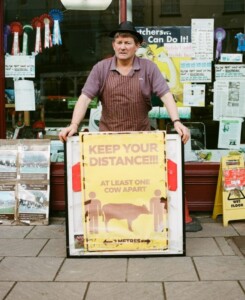
William Lloyd Williams outside his award-winning shop in Machynlleth
William Lloyd Williams runs a butcher’s shop right in the heart of Machynlleth, and a small-scale abattoir, quite literally, over the road. William says, ‘Just think that nothing can move in agriculture without a paper trail, so if you take your livestock to the abattoir, there will be paperwork. In my shop, I have every single piece of paper detailing where, when and how my animals were moved. That’s called traceability.’ William is so confident about his transparency that he has the transport papers accessible for any customer who would like to see them.
Butcher John Mettrick says, ‘It’s about telling your customers everything about the meat you sell – where it’s from, how it was raised and fed, how it was slaughtered, how long it’s been hung, everything that gives the customer the confidence to buy your meat.’
Stephen Hill is butcher and abattoir owner at Perry’s of Eccleshall in Staffordshire. Stephen talks about the importance of their local abattoir improving traceability, ‘People like the fact we have an abattoir on site, knowing the whole story – its welfare, the name of farmer who raised it, down to what breed the animal is. For us, knowing where your food comes from is what we are all about.’
Callum Edge of Edge & Sons Butchers says, ‘It’s so easy for us to do our traceability. We can control what comes in and out of our abattoir and assess the quality of the meat first-hand. The relationship with our farmers is strong, and we know exactly what we are getting from each farmer.’
Jane Oglesby supports this, ‘Callum is massively important in controlling and sustaining the high animal welfare we give our livestock throughout their lives. When you give your livestock to an abattoir, the care is out of your control, and the work you have done up until then can be spoilt through the care – or lack of – in the abattoir. However, with Edge & Sons, I know they will be kept in a safe, calm environment, which is proved in the quality of the meat.’
Many of the butchers and slaughtermen I spoke to mentioned the importance of the local abattoir in sustaining skills and tradition. John Mettrick notes, ‘A slaughtermen is an official trained role, one that is extremely skilled and takes great pride and respect in dressing each animal.’ The concern is, however, that if we see local abattoirs being lost, these skills will also disappear. As Stephen Hill says, ‘We can’t lose these skills that have been learned for centuries. In the smaller abattoirs, for example, the slaughtermen do all of the jobs on all types of livestock, whereas with larger abattoirs, they simply do one job, and that’s it.’
The farmers and butchers also spoke about the importance of local abattoirs serving the local community. As John Mettrick says, ‘We are the bridge between the farmer and customer, supplying the community with produce we are proud to sell. We are always involving ourselves in lots of local clubs and sports. Recently, for example, we have been able to provide free meals for local children during the school holidays.’
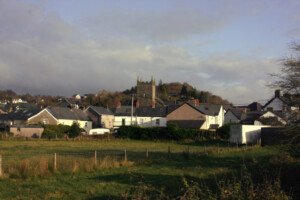
Machynlleth
William Lloyd Williams also believes that having his local abattoir serves the community, ‘We give local people something to be proud about, something to boast about knowing where their food comes from.’ It was clear when visiting William at his butcher’s shop that he is a pillar of the community – not a soul that passed by didn’t say hello to him, cars even honking their horns as they drove past. It seemed that his sincerity in business was exemplary in his character as well.
That brings us to the ‘fork’ end of the ‘field to fork’ journey, the consumer. I spoke to a number of them entering their local butcher’s shop on the subject of the local abattoirs serving them. ‘The fact of having a local abattoir nearby, gives me confidence in buying their meat, and the locality of it all really comes out in the taste,’ says Adrian Foulkes, a local businessman who buys from William Lloyd Williams in Machynlleth. He continues, ‘It’s great that William knows exactly where his meat comes from.’
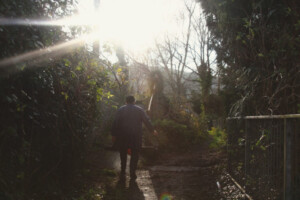
Rhian Chirgwin, another customer at William Lloyd Williams, says, ‘Every single piece of meat that I buy from William has a local story to it, which is really great to hear.’ Another lady says, ‘It’s super to know William has his local abattoir so near to the livestock and shop; there’s not much carbon footprint in a hundred yards is there!’ So close is William’s shop and abattoir, he even led me on the 147-step walk between the two.
Stephen Hill from Perry’s of Eccleshall, says, ‘The relationship with our customers is absolutely key. A lot more people want to know where their meat comes from, and we are happy to tell them. As long as you can prove what you do, how you operate, be transparent in everything you do, people buy into it much more.’
Callum Edge talks about how environment and diet concerns factor into his customer’s buying habits, ‘Consumers are now far more knowledgeable about what they want to eat, where it’s from, how far it’s travelled and how nutritious it is. Whether they have learnt that information through the Internet or through word of mouth, it just goes to show that our business is the busiest it’s ever been. I love that they want to eat less, but better meat, which is healthier for them and the environment.’ He continues, ‘We work with a lot of farmers that are organic and use regenerative methods, and I would say that now we have the strongest relationship we’ve had with our customers in the last 50 years because people now want to have that knowledge of eating for the environment.’
Mettrick also notes that his customers like to buy his lamb because they have a low carbon footprint, ‘We only get our lamb from farmers about 5 miles down the road.’
The benefit of local abattoirs extends to the fact that they themselves have the ability to pivot when issues arise. John Mettrick mentions, ‘If there are any national issues, like in the past with foot-and-mouth disease or BSE, small and local supply chains come into their own, they are more reactive and efficient to change quickly, that is because they know each stage and person in the process.’
It seems from speaking to farmers, butchers, small-scale abattoir owners and consumers that the benefits of having local abattoirs are extensive and diverse at every stage of the supply chain. Farmers are generating a premium for their meats; butchers have the ability to control and sustain high levels of traceability, provenance, knowledge and skills; and consumers can confidently address their environmental and dietary concerns.
I’ll leave you with Shelia Oliver, the farmer in Derbyshire, who sells her livestock through her local abattoir, Mettrick’s Butchers, who summarises, ‘Why would I want to go anywhere else, when I have a local abattoir, where I can speak to the butcher and customers directly, and know exactly where my meat is going?’
